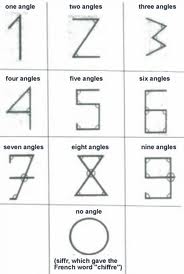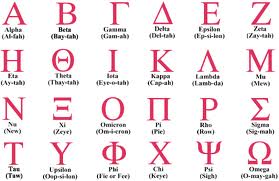Counting with letters
The numerals we use were popularized in Europe by Leonardo Fibonacci. We have some evidence (in the form of a date on a sign on a coal mine or something mundane like that) that our numerals were known in Europe before 1202, but Fibonacci generally gets the credit for popularizing them. Here’s a cleaned-up chart of the originals:
Before that, we had Roman Numerals, of course, but what did we use to count with before the Romans? We used letters.
Before I tell you how that works, I must mention numerology. Numerology is the practice of assigning numerical values to letters, counting up the sum, and looking for interesting patterns in the numbers you get. The most common way nowadays it to assign the values 1 through 26 to the letters of the English alphabet. Numerologists manipulate results pretty much at will; consequently you can prove anything you like with numerology if you work at it. It’s a bunch of hokum. I even figured out how to prove that I, your humble curmudgeon, am the antichrist! Ask me how and I’ll tell you. It’s all very clear, and completely bogus.
Since at least the Greeks and the Hebrews actually did use letters (other groups had a pile of other systems), you can assign a numerical value to a word. When the Greeks were actually counting, they put a mark at the corner of the letter to show that it was being used as a numeral. But they didn’t go from 1 to 26 (okay, 24) in assigning the values. First, here’s a Greek alphabet.
Numbers, like musical terms and place names, tends to be conservative linguistically, and that leads to a monkey wrench. Between epsilon and zeta, when you’re counting, you have to insert an obsolete letter called a digamma. The digamma looks like a capital F, and it stands for six. Keep counting, and you get to iota standing for ten. Kappa is 20, not eleven. Lambda is 30, and so on, until you get to the next monkey wrench between pi and rho. In goes another obsolete letter, qof, which looks like a lollipop, and it stands for 90. Hence, rho is 100. Sigma is 200, and so on. I don’t know of a letter for 900, and they used a word for a thousand, related to our word myriad. So if you want to say you have 23 sheep, you would use kappa gamma with a mark after the two letters.
Obviously, with a system like this you can assign values to actual Greek words pretty easily. Look up the numerical values and add them up. It’s from this practice that we get the expression “the number of a name.”
And having used that expression, I have to bring up the book of Revelation and the number of the beast. What I described above is how you get to the infamous 666. You have a few problems figuring out who he is, though.
- It’s easy to get from a word to a number, but hard to get from a number to a word. Try it.
- What language do you use? Classical Greek? Modern Greek? Hebrew? Latin? Aramaic? Italian? King James English? Whatever language the beast speaks?
- What name do you use? First name? Title? Whole name? Last name? Maybe his secret name. How about nickname? Or the name his opponents call him?
Obviously it’s going to be hard to figure out who the guy is in advance, and plenty of people have figured out plenty of ways to assign 666 to a lot of famous folks enemies. My recommendation: make it into a party game. Use something like the Greek method on the English alphabet, and assign people their numbers accordingly. Make up some rules, such as the higher your number the more intelligent (or some other desirable characteristic) you are. Perhaps the closer your numbers are, the more compatible, and you can add the number of your pet’s name to bring your numbers closer together. Married people who have the same last name would be very compatible.
The sky’s the limit.



My love for words may well be surpassed by my love for numbers. This is a great post, Rogers. The party game sounds imaginatively delightful.
Red.
Rev.13:18 Here is wisdom. Let him that hath understanding count the number of the beast: for it is the number of a man; and his number is Six hundred threescore and six.
God didn’t say his number is 666. His number is SIX HUNDRED THREESCORE AND SIX. We use simple gematria to count the number. A=1,B=2,C=3…Z=26.
SIX HUNDRED THREESCORE AND SIX Total count =313 and 26 letters
VLADIMIR VLADIMIROVICH PUTIN Total count =313 and 26 letters
TWENTY AND SIX; TWENTY=107 AND =19, SIX=52
Vladimir Putin birth date 10-7-1952
Vladimir Putin is the beast of rev. 13:18
God gets all the glory and credit!